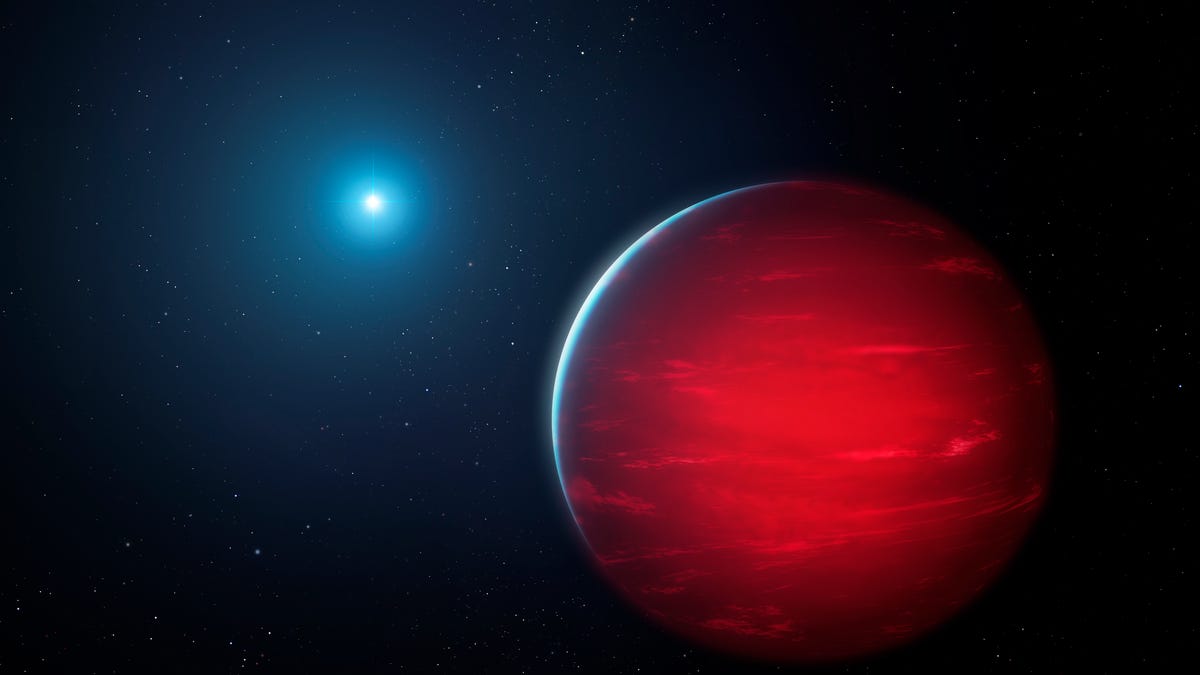This Record-Breaking Star System's Year Is Shorter Than One Earth Day
Its two stars revolve around one another quickly enough for astronomers to watch in real time, a rare treat.

An illustration of an ultracool dwarf star (front, red) with a companion white dwarf (back, white with blue haze).
It's always a rare delight when astronomers stumble upon an untouched gem in our universe, but it feels extra exhilarating when that discovery earns a coveted spot in our cosmic hall of fame. It's these record-breaking beauties that inspire much more than awe. They also invite us into the next level of space exploration.
On Tuesday, during an annual American Astronomical Society meeting in Seattle, a crew of astronomers announced that it's located a new, and curious, star system. But this sparkly structure hadn't just remained invisible to human eyes for decades. Its two stars complete a revolution around each other faster than any low-mass stellar binary system ever observed.
"It's exciting to discover such an extreme system," Chih-Chun "Dino" Hsu, a Northwestern University astrophysicist who led the study, said in a statement. "In principle, we knew these systems should exist, but no such systems had been identified yet."
Simply, this multibillion-year-old low-mass system, dubbed LP 413-53AB, holds two stars that are considered "ultracool dwarfs," meaning they are so cool they emit their light primarily in the infrared region of the electromagnetic spectrum.
Unlike normal red light waves (or blue, purple, green and so on), infrared waves don't fall within the visible region of the spectrum. Thus, humans can't detect them with the naked eye. In fact, the iconic James Webb Space Telescope is built to pick up precisely this kind of light wave, which is why it's such a big deal and boasts the promise of "unveiling an unfiltered universe."
This infographic illustrates the spectrum of electromagnetic energy, specifically highlighting the portions detected by NASA's Hubble, Spitzer, and Webb space telescopes.
But returning to these ultracool dwarfs, the infrared bit isn't even the main drawing point, despite how awesome the concept is in itself. This duo also appears to have broken the record for how immensely fast the components of this kind of stellar system can complete an orbital revolution around one another.
They do it in just 20.5 Earth hours.
It actually means the distance between these two stars is only about 1% the distance between our planet and the sun.
"This is remarkable, because when they were young, something like 1 million years old, these stars would have been on top of each other," Adam Burgasser, co-author of the study and an astrophysicist at the University of California at San Diego, said in a statement.
This incredibly short "year" of LP 413-53AB (sorry to make you read that robotic name twice) is at least three times shorter than all ultracool dwarf binaries discovered so far, the researchers say. And that includes the other three "short-period" ones detected to date.
"These systems are rare," Chris Theissen, study co-author and an astrophysicist at the University of California at San Diego, said in a statement. "But we don't know whether they are rare because they rarely exist or because we just don't find them. That's an open-ended question. Now we have one data point that we can start building on."
Fascinatingly, a serendipitous consequence of tracking a star system with such a short orbital period is that scientists can watch its movement before their eyes.
Typically, space-related phenomena progress over many days, many years and often, many millennia. You can't exactly just look up at the sky, for instance, and watch Jupiter making its way around the sun. But with the newly identified stars stuck in a tight lockstep, you kind of can. "This data had been sitting in the archive for a long time," Burgasser said.
The team traced spectrums of light emitted by the two stars -- each one represented by a "spectral line" that indicates the objects' motion as they get farther away from Earth, and then closer again.
"With this system, we could see the spectral lines moving apart in real time," Burgasser said. "It's amazing to see something happen in the universe on a human time scale."
In terms of why this stellar pair has such a uniquely compact structure, the team suggests that perhaps, long ago, there was a third member in the starry waltz. But maybe it got lost, forcing these two to gravitationally bond and get a little too close. Or, maybe it was always just the two of them and they naturally treaded toward one another.
Of course, these are still theories. As Hsu put it during a press conference about the findings, "future observations are needed to anchor it to its true origin." When that happens, hopefully, a record shall be broken once more.

